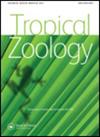大西洋森林溪流中低风性摇蚊幼虫的形态特征及垂直分布
IF 0.4
4区 生物学
Q4 ZOOLOGY
引用次数: 4
摘要
下潜带是由河床颗粒间的间隙构成的活动过渡带。利用形态特征可以有效地检测这些地区的生物分布模式。关于拟隐群落的垂直分布资料也很少。在三个深度和四个微生境中采集了潜流带的动物群样本。记录了18个属,鉴定了13个形态特征。结果表明,潜潜摇尾鱼类群的分布格局因深度和微生境的不同而不同。其空间分布与体型、拟足、动量等形态特征相关。动物丰度和丰富度随深度的增加而降低,垂直分布影响摇尾鱼的形态特征。我们认为,利用形态特征可以提供关于潜潜区系分布的新的有用信息。http://zoobank.org/urn:lsid:zoobank.org:pub:E1DDF958-AA8C-40FD-A0D5-F281AA4AEA04本文章由计算机程序翻译,如有差异,请以英文原文为准。
Morphological traits and vertical distribution of hyporheic chironomid larvae in Atlantic Forest streams
Hyporheic zone is an active ecotone constituted by the interstitial spaces between the particles of the riverbed. The use of morphological traits can be useful to detect organisms distribution patterns in these areas. Information concerning hyporheic communities are scarce as well on chironomid vertical distribution. Fauna samples from the hyporheic zone were collected at three depths and in four microhabitats. Eighteen genera were recorded and 13 morphological traits were identified. The results indicate that the distribution patterns of hyporheic chironomid taxa vary according to depth and microhabitat. Spatial preferences for riffles habitats are evident, and the vertical distribution is correlated with morphological traits like body size, pseudopods and mentum. Faunal abundance and richness decreased with depth and the vertical distribution influenced the chironomid morphological traits. We conclude that the use of morphological trait can introduce new useful information about the distribution of hyporheic fauna. http://zoobank.org/urn:lsid:zoobank.org:pub:E1DDF958-AA8C-40FD-A0D5-F281AA4AEA04
求助全文
通过发布文献求助,成功后即可免费获取论文全文。
去求助
来源期刊

Tropical Zoology
生物-动物学
CiteScore
2.50
自引率
0.00%
发文量
1
审稿时长
>12 weeks
期刊介绍:
Tropical Zoology is an international zoological journal publishing original papers in the field of systematics, biogeography, phylogeny, ecology and conservation of all terrestrial and aquatic animal Phyla from tropical and subtropical areas.
Only papers with new information, high quality and broad interest are considered. Single species description and checklists are not normally accepted. Review papers are welcome. The journal is owned by the Istituto di Ricerca sugli Ecosistemi Terrestri of the Consiglio Nazionale delle Ricerche, Florence, Italy (CNR-IRET) who performs research into the structure and functioning of aquatic and terrestrial ecosystems, focusing in particular on anthropogenic pressure and global change. The knowledge amassed forms the scientific basis for identifying the most appropriate protective and corrective interventions, and provides support for the bodies entrusted with formulating policies for environmental protection and recovery.
 求助内容:
求助内容: 应助结果提醒方式:
应助结果提醒方式:


